Rescue Towing
Teach the concepts behind the different rescue tows and which to use for what type of casualty.
When all other attempts to get the casualties out have failed, then you may have to go in and and get them. Only as a last resort should you enter the water and tow a casualty back to safety. Enter the water safely, you may not know the conditions.
There are many different tows. Some have regional variations. The correct rescue tow depends on the casualty. Discuss and practice the main rescue tows with your class. Compare results and work out which tow works best for a given casualty.
Always keep the casualty's face out of the water. Some towing techniques extend their airway for better breathing, but it can also let water in if you're not careful. Do not push against the throat, or your casualty can't breathe.
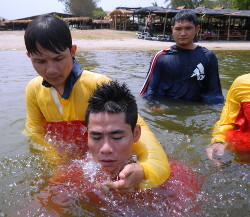
Tell - Show - Try - Do
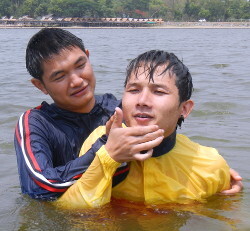
Extended Arm Tow
Use this tow with cooperative or unconscious casualties. It is the easiest tow if you relax the towing arm. Your casualty should be towed behind you, not beside you which would be too much effort. Hold on to the chin, not the throat. Use side stroke or lifesaver's backstroke and don't kick the casualty.
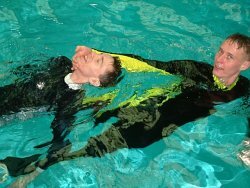
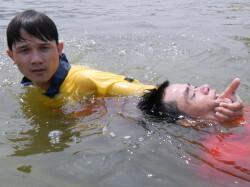
Clothes Tow
The clothes tow is used to help swimmers who are tired but not struggling.
The rescuer grabs the clothes on the casualty's back between the shoulders
and pulls him to a horizontal position, floating on his back.
He maintains his hold of the casualty's clothes,
keeping his arm fully extended,
and uses the sidestroke while towing.
Chin Tow
This is a tow for a weak or fearful casualty.
It feels reassuring to the casualty because you're very close; they don't drift in open water.
You have your legs and one arm to push forward with.
Cross Chest Tow
In rough water this tow keeps the casualty's face higher above the water. Use side stroke so you can also use your free arm for swimming.
Reach over the casualty's shoulder and jam them in between your arm and side.
If the casualty wears jeans, you may grab hold of their belt or a belt loop.
Head Tow
This is another tow for a cooperative casualty. Holding the head gives good control and feels reassuring to the casualty.
The drawback is that you only have your legs to push forward with.
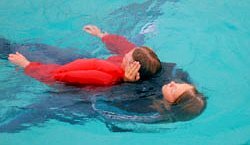
Shoulder Tow
This is yet another tow for a weak or non-swimmer who needs to be taken across deeper water.
Ask the casualty to hold on to your shoulders or waist whilst you swim with normal breaststroke.
Only use this tow with people who you can trust to behave and not to panic.
Push a Co-operative Casualty
This tow is mainly taught in Germany.
Approach your casualty from the front, tell him/her to hold on to your shoulders whilst you swim with normal breaststroke.
The advantage is that you can keep an eye on your casualty and they can see you which is very reassuring.
Only use this tow with people who you can trust to behave and not to panic.